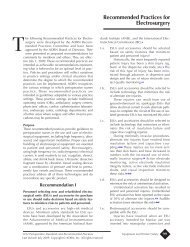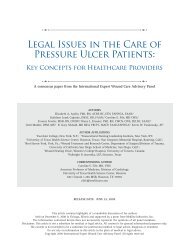2009 CAUTI guidelines - Centers for Disease Control and Prevention
2009 CAUTI guidelines - Centers for Disease Control and Prevention
2009 CAUTI guidelines - Centers for Disease Control and Prevention
You also want an ePaper? Increase the reach of your titles
YUMPU automatically turns print PDFs into web optimized ePapers that Google loves.
After determining the GRADE of the evidence base <strong>for</strong> each outcome of a given intervention orquestion, we calculated the overall GRADE of the evidence base <strong>for</strong> that intervention orquestion. The overall GRADE was based on the lowest GRADE <strong>for</strong> the outcomes deemedcritical to making a recommendation.Table 3. Rating the Quality of Evidence Using the GRADE ApproachType ofEvidenceInitialGradeCriteria to DecreaseGradeCriteria to IncreaseGradeOverallQuality GradeRCT High QualitySerious (-1 grade) orvery serious (-2 grades)limitation to study qualityObservationalstudyAny otherevidence(e.g., expertopinion)LowVerylowConsistencyImportant inconsistency(-1 grade)DirectnessSome (-1 grade) or major(-2 grades) uncertaintyabout directnessPrecisionImprecise or sparse data(-1 grade)Publication biasHigh risk of bias (-1grade)Strong associationStrong (+1 grade) orvery strong evidenceof association (+2grades)Dose-responseEvidence of a doseresponsegradient (+1grade)UnmeasuredConfoundersInclusion ofunmeasuredconfoundersincreases themagnitude of effect(+1 grade)HighModerateLowVery lowFormulating RecommendationsNarrative evidence summaries were then drafted by the working group using the evidence <strong>and</strong>GRADE tables. One summary was written <strong>for</strong> each theme that emerged under each keyquestion. The working group then used the narrative evidence summaries to develop guidelinerecommendations. Factors determining the strength of a recommendation included 1) thevalues <strong>and</strong> preferences used to determine which outcomes were "critical," 2) the harms <strong>and</strong>benefits that result from weighing the "critical" outcomes, <strong>and</strong> 3) the overall GRADE of theevidence base <strong>for</strong> the given intervention or question (Table 4). 33 If weighing the "criticaloutcomes" <strong>for</strong> a given intervention or question resulted in a "net benefit" or a "net harm," then a"Category I Recommendation" was <strong>for</strong>mulated to strongly recommend <strong>for</strong> or against the givenintervention respectively. If weighing the "critical outcomes" <strong>for</strong> a given intervention or questionresulted in a "trade off" between benefits <strong>and</strong> harms, then a "Category II Recommendation" was<strong>for</strong>mulated to recommend that providers or institutions consider the intervention when deemedappropriate. If weighing the "critical outcomes" <strong>for</strong> a given intervention or question resulted in30
















